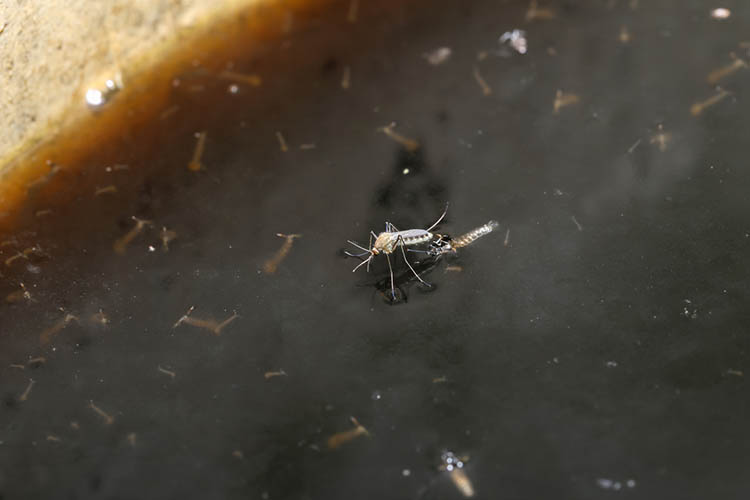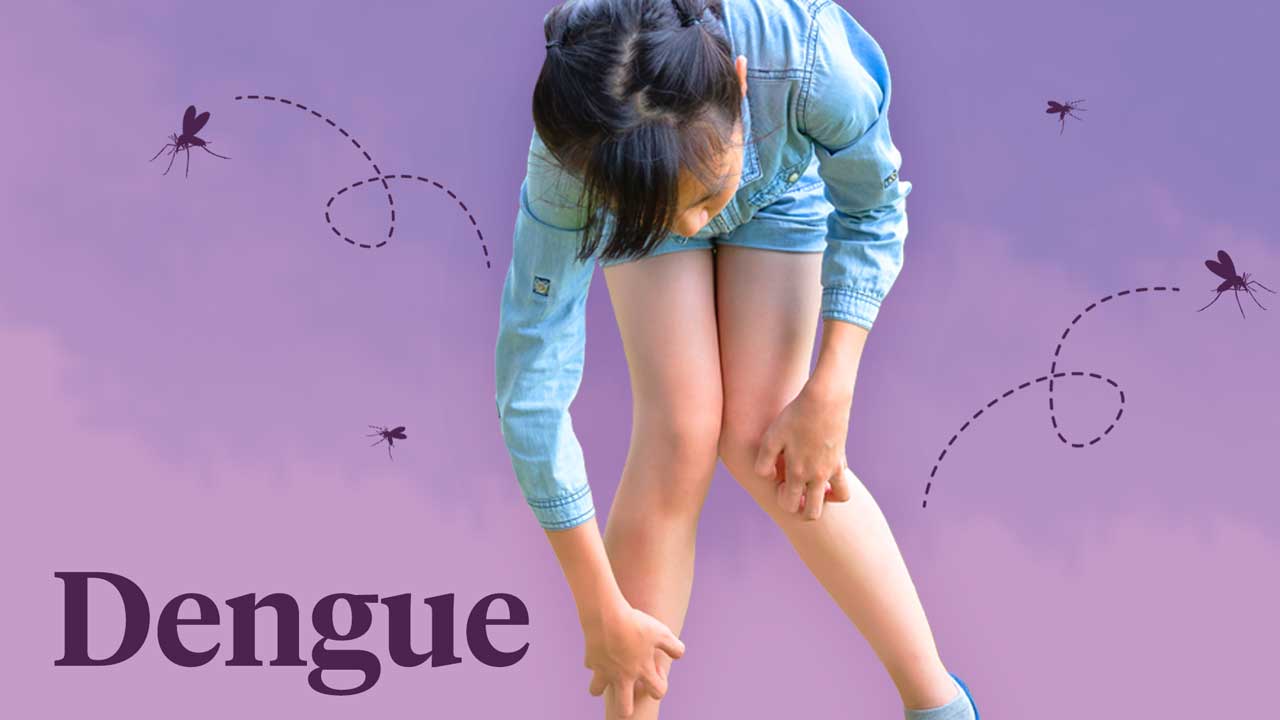Dengue is estimated to affect up to 400 million people worldwide every year (WHO 2023).
Dengue is not endemic in Australia (Queensland Health 2021). However, it became nationally notifiable in 1991. There are varying numbers of cases every year in Australia, sometimes in excess of 1,000. Most recently, in 2022, there were 536 notifications (DoHaAC 2023).
The largest recent outbreak in Australia was in 2016, when there were over 2000 confirmed cases, including many from Western Australia, Victoria and New South Wales (DoHaAC 2023).
While outbreaks can be contained, constant surveillance is needed.
What is Dengue?
Dengue is a mosquito-transmitted virus that causes dengue fever, a flu-like illness (Queensland Health 2021; Healthdirect 2023).
There are four genotypes of dengue virus (known as DENV-1, DENV-2, DENV-3 and DENV-4). A person infected with dengue will generally develop lifelong immunity to the particular genotype they contracted. However, they will still be susceptible to the others (NSW Health 2022).
How is Dengue Spread?
Dengue is transmitted through a bite from two types of mosquito: the Dengue mosquito (Aedes aegypti) and the Asian Tiger mosquito (Aedes albopictus) (Healthdirect 2023).
Aedes aegypti can be found in Central and Far North Queensland, while Aedes albopictus can be found in the Torres Strait (NSW Health 2022).
Aedes aegypti mosquitoes feed predominantly on humans, breed in small man-made areas that contain water, rest inside buildings and are usually found in close proximity to human habitation. They are, therefore, highly effective at transmitting disease (Queensland Government 2020).
Mosquitoes acquire dengue by feeding on blood from an infected human. The virus requires an incubation period of 8 to 12 days inside the mosquito before it can be transmitted to another human. Once infected, the mosquito will carry and transmit the virus until it dies (WHO 2023).
Generally, infection in Australia occurs when a traveller is bitten by a mosquito overseas and infected with dengue, then returns to Australia and is bitten by a local Aedes aegypti or Aedes albopictus mosquito. This mosquito can then spread the virus to other people in Australia (NSW Health 2022).
Occasionally, dengue can be transmitted through blood transfusions, tissue or organ transplants, needlestick injuries and mucous membrane contact with infected blood. However, it cannot be spread directly from person to person (NSW Health 2022).

Symptoms of Dengue Fever
Dengue symptoms may vary from mild or even unnoticeable (more often in children) to fatal (Queensland Government 2020).
Typically, 3 to 14 days after a mosquito bite, the patient will experience a sudden onset of symptoms that may include:
- Fever
- Chills
- Extreme tiredness
- Muscle and joint pain in the ankles, knees, and elbows, which can be so intense that dengue fever has also been called ‘breakbone fever’
- Intense headache, sometimes with pain behind the eyes
- Swollen glands
- Nausea and vomiting
- Loss of appetite
- Diarrhoea
- Abdominal pain
- Metallic taste in the mouth
- Flushed skin on face and neck
- Fine skin rash on the arms and legs as the fever subsides, sometimes with itching, peeling of skin and hair loss
- Bleeding from the nose or gums and heavy menstrual periods.
(Queensland Government 2020; NSW Health 2022; Schaefer et al. 2022)
Diagnosis of Dengue
Depending on the clinical presentation and patient history, dengue may need to be differentiated from other illnesses, such as chikungunya, measles, influenza, yellow fever, Zika and malaria (Schaefer et al. 2022).
Definitive diagnosis is achieved through blood tests (Healthdirect 2023).
Treatment of Dengue
There is no specific cure for dengue fever. Treatment should include rest, plenty of fluids and paracetamol for pain (not aspirin or non-steroidal anti-inflammatory medicines (NSAIDs), which increase the risk of bleeding) (NSW Health 2022). Dengue fever usually resolves in one to two weeks, but lethargy and depression may persist (Better Health Channel 2018; SA Health 2022).
In some cases, especially in children and young adults, dengue may progress to severe dengue (also known as dengue haemorrhagic fever) (Healthdirect 2023). Some 3 to 7 days after the initial symptoms, someone with severe dengue will experience a decrease in fever but onset of symptoms including:
- Severe abdominal pain
- Persistent vomiting with blood in the vomit
- Rapid breathing
- Bleeding into the skin (producing purple bruising) and from the nose and gums
- Fatigue, restlessness and confusion
- Cold and clammy skin.
(NSW Health 2022; Healthdirect 2023; Queensland Government 2020)
In extreme cases, severe dengue may lead to shock, coma and death (Better Health Channel 2018).
In these cases, rapid volume replacement may be required (Smith 2022).
Preventing Dengue

Prevention of dengue is mainly achieved through mosquito control. This involves getting rid of breeding sites (any open container that holds water around homes and workplaces) and using surface spray insecticides in homes. Personal protection is also important, especially when travelling to endemic areas (Queensland Government 2020).
Topics
References
- Better Health Channel 2018, Dengue Virus Disease, Victoria State Government, viewed 5 December 2023, https://www.betterhealth.vic.gov.au/health/conditionsandtreatments/Dengue-virus-disease
- Department of Health and Aged Care 2023, National Communicable Diseases Surveillance Dashboard, Australian Government, viewed 5 December 2023, https://nindss.health.gov.au/pbi-dashboard/
- Healthdirect 2023, Dengue Fever, Australian Government, viewed 5 December 2023, https://www.healthdirect.gov.au/dengue-fever
- NSW Health 2022, Dengue, New South Wales Government, viewed 5 December 2023, https://www.health.nsw.gov.au/Infectious/factsheets/Pages/dengue.aspx
- Queensland Government 2020, Dengue, Queensland Government, viewed 5 December 2023, https://www.qld.gov.au/health/condition/infections-and-parasites/viral-infections/dengue
- Queensland Health 2021, Dengue: Virus, Fever and Mosquitoes, Queensland Government, viewed 4 December 2023, https://www.health.qld.gov.au/clinical-practice/guidelines-procedures/diseases-infection/diseases/mosquito-borne/dengue/virus-fever
- SA Health 2022, Dengue Fever - Including Symptoms Treatment and Prevention, Government of South Australia, viewed 5 December 2023, https://www.sahealth.sa.gov.au/wps/wcm/connect/public+content/sa+health+internet/conditions/infectious+diseases/dengue+fever/dengue+fever+-+including+symptoms+treatment+and+prevention
- Schaefer, TJ, Panda, PK & Wolford, RW 2022, ‘Dengue Fever’, StatPearls, viewed 5 December 2023, https://www.ncbi.nlm.nih.gov/books/NBK430732/
- Smith, DS 2022, Dengue Treatment & Management, Medscape, viewed 5 December 2023, https://emedicine.medscape.com/article/215840-treatment#d9
- World Health Organisation 2023, Dengue and Severe Dengue, WHO, viewed 4 December 2023, https://www.who.int/news-room/fact-sheets/detail/dengue-and-severe-dengue
 New
New 
